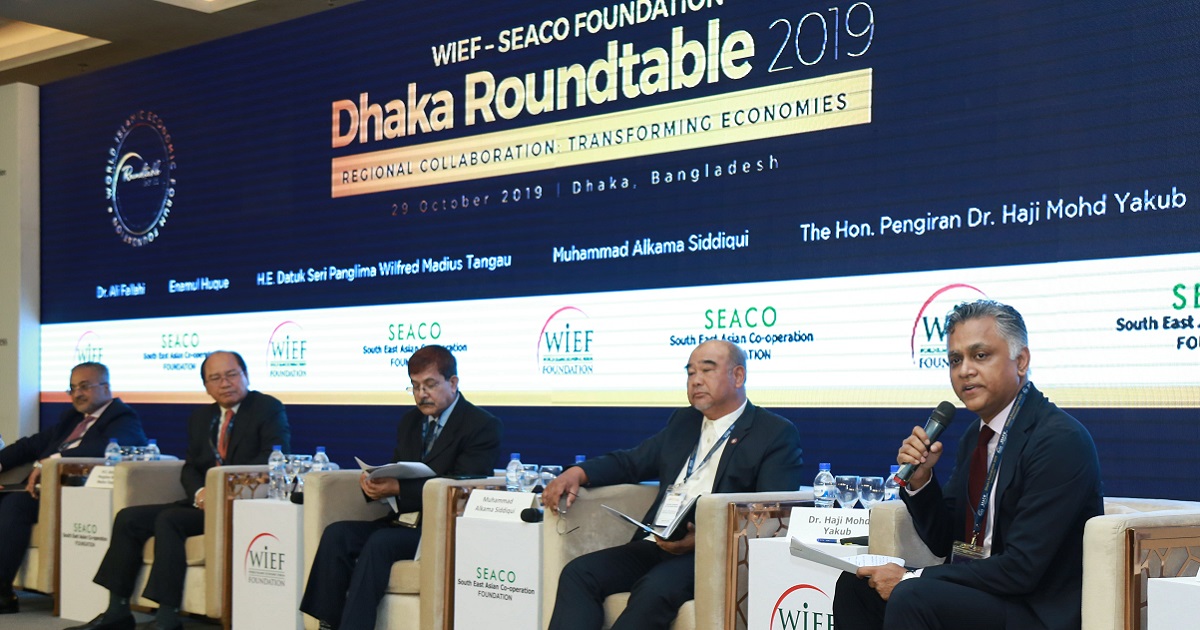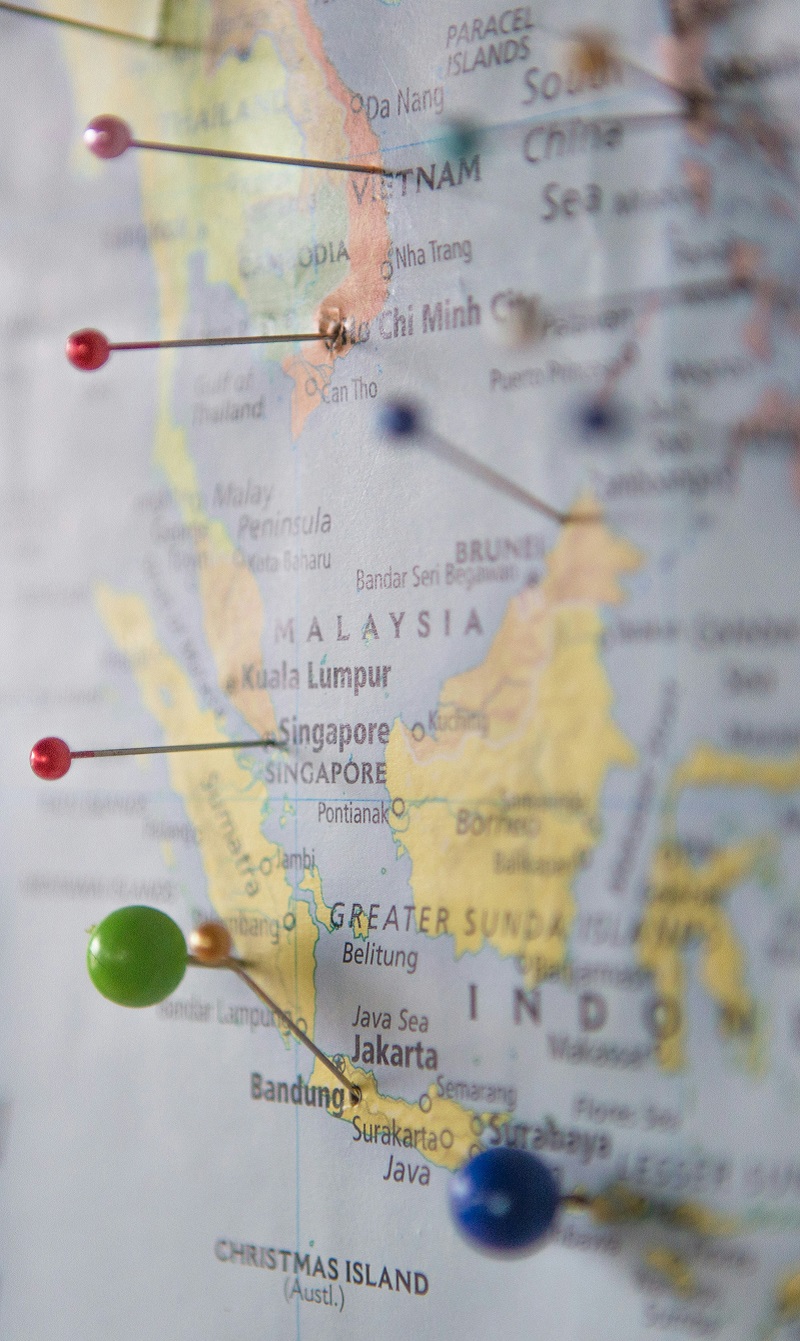Rethinking Infrastructure Development
One of four sessions during WIEF-SEACO Foundation Roundtable 2019 in Dhaka discusses Rethinking Infrastructure Development: Laying the Foundation for Prosperity in terms of the role of cross-border infrastructure in the context of regional collaboration and new financing opportunities to help improve the delivery of sustainable infrastructure. Here are the highlights.
Fuelled by rapid urbanisation and population growth, Asia is facing a growing infrastructure deficit – between what is needed and what is available. Thus, during the first session of WIEF-SEACO Foundation Roundtable in Dhaka five experts from Brunei, Indonesia and Bangladesh discussed Rethinking Infrastructure Development, Laying the Foundation for Prosperity. Here is a summary.
The World Bank and WEF, according to session moderator Syed Nasim Manzur, managing director of Apex Footwear Limited, estimated that for almost every USD1 spent on infrastructure, the multiplier effect in terms of economic growth can be five to 15 per cent. There’s a global deficit of infrastructure and by some estimates, as high as USD25 trillion in terms of financing deficit. Bangladesh faces similar challenges. Recently it scored 27 out of 28 in access to physical infrastructure index. In the last two years, it saw an acceleration in investments of up to USD6 billion in infrastructure. However, in terms of percentage spending, Bangladesh still lags behind at around 2.58 per cent of GDP, versus 10 to nine per cent in countries like China as well as five per cent in countries like Sri Lanka and India.
Chief speaker of the session, Datuk Seri Panglima Wilfred Madius Tangau, Deputy Chief Minister of Sabah as well as its state minister of Trade and Industry relays how the development in Malaysia experienced the current GDP of more than RM1 trillion, and 40 per cent of that is actually generated from two Malaysian states of Selangor and the Federal Territory of Kuala Lumpur. It’s facilitated by infrastructure which included a port and airport. Alternatively, for instance, the port in Johor has about 54 cranes compared to Sabah’s Sepangar Bay Port that has only around four cranes. Furthermore, the GDP of Sabah is about RM80 billion, which is hardly six per cent of the total Malaysian GDP. Therefore, in terms of competing for investment, Sabah isn’t competitive and it’s largely due to logistics. The state is open to ideas on financing.
Enamul Huque, managing director of Standard Chartered Bank in Bangladesh, reports how print economies globally contribute about 83 per cent of growth, of which 10 countries of East, East Asia and South Asia, contribute about 39 per cent of growth in 2019. Five-year forecast is that the proposition got to be changed for 20 countries to 79 per cent, out of which 10 countries will contribute almost 59 per cent of the growth opportunity. Which means, opportunities are enormous in the region. Each year, USD1.7 trillion is needed for infrastructure. A bank may be able to assist in terms of tackling concerns such as market integration in terms of non-tariff failures, red tapes, transportation cost and connectivity. Furthermore, banks have a significant role in terms of bringing financial decisions into place when it comes to capital flow for infrastructure fund development. Lastly, Islamic markets such as Malaysia remain at the forefront in terms of sukuk and other Islamic finance products. Bangladesh can be beneficial to Islamic products solutions where banks have a significant role to play. It can also have an indicative global quantity between Indonesia, Malaysia and Bangladesh, or in sub-continent countries in terms of financial solutions.
Pengiran Dr Mohd Yakub bin Pengiran Haji Othman, an advisor from Brunei-China One Belt One Road Association, speaks of integrating within the framework of South Asia and Southeast Asia to boost competitiveness within the region. Brunei has been struggling to achieve economic diversification. Despite the increasing trade among ASEAN countries and the increase in trade between ASEAN and the rest of the world, Brunei’s economic growth is probably the lowest in the region of one to two per cent a year compared to Vietnam, Laos and Cambodia. This seems to be the ‘Dutch disease’, where oil producing countries don’t perform well. It’s not an economic reason. Despite improvements on Brunei’s economic environment, investments aren’t coming and it may be because foreign investors have a choice of 10 countries to invest their money. ASEAN has been successful in attracting foreign direct investments and AFTA (ASEAN Free Trade Area) has resulted in trade creation effect, where both the intra-trade and trade with the rest of the world, have increased. On the same vein, SEACO must be used to increase business and trade among its member countries.
Recently, according to Dr Ali Fallahi, country economist of Islamic Development Bank (IDB) Regional Hub in Indonesia, IDB’s transforming and re-positioning itself to become a bank of developers and to connect stakeholders to the development journey of its member countries. IDB has recently implemented its new generation of Member Country Partnership Strategy (MCPS) and is now focusing its 20 per cent of its efforts on industry that have 80 percent impact for the countries. IDB wants to help facilitate the integration of its member countries, whether it’s in South Asia or Southeast Asia. This is why SEACO may be a good platform and initiative where connectivity can happen between member countries in South Asia and the free member countries in Southeast Asia.
Muhammad Alkama Siddiqui, CEO of Public Private Partnership (PPP) Authority, Prime Minister’s Office of Bangladesh, answers on what are PPP Authority doing to accelerate the country’s much needed infrastructure and what innovative ideas can be expected. Infrastructure and development go hand-in-hand. Without development, without infrastructure, there’s no prosperity. As of a few years ago, a specific portion of the budget assigned to PPP Authority acknowledged the increasing need for infrastructure development and that there was a visible gap when it came to financing. Furthermore, without involving the private sector this huge gap would remain open. Now, the PPP process has evolved in terms of financing large infrastructure plans, able to finance any size of infrastructure in communication, transport, energy and in social sectors. In fact, there are 74 projects in different sectors including Dhaka elevated expressway, other big projects in Bay Terminal in Chittagong Port Authority and Khan Jahan Ali Airport in Bagerhat. The Bangladeshi Prime Minister’s special focus is involving private sector in financing, for instance, large infrastructures.
In a Nutshell by Session Moderator
Dr Wilfred Tangau talked about how infrastructure is very expensive and to realise that not only governments but private sector players as well have a role to play. Waiting for financing from government will take too long and this is echoed by Sidiqqui. New and innovative ideas on financing are needed. Huque’s powerful point about how the top 10 Asian countries will account for 59 per cent of global economic growth within the next decade and talks about how banks can assist with integration. This is a wakeup call because there’s not enough intra-trade, intra-investment, within this region. So I hope this will be a wakeup call.
Of course, reaching out to the experienced policy advocated present, there’s a need for major structural policy reform. To invest overseas and greater cross-border investments must be permitted. Dr Yakub raised an interesting point of whether global-regional integration is equally good for member countries. The answer is no with Vietnam versus Brunei, as an example, because Vietnam benefits greatly from the tariff wars of the United States and their exports continue to power ahead at more than 13 per cent while the rest of the world struggle to even hold at par.
Furthermore, organisations such as SEACO needs to be more than just a political grouping but become an entity which stands for business and drives trade. This highlights Dr Ali Fallahi’s point on how the IDB wants to be a bank of developers. It’s very difficult now to find investors with a long-term perspective because investments on hard infrastructure tend to be very low yield and very long term, at a time when markets aren’t known to be long term and low yield oriented. Dr Fallahi brings up global value chains and also points out impact investment that concentrates on the 20 per cent instead of being everything, everywhere. We can’t be competitive in every sector.
Sidiqqui explains how the Bangladesh government has prioritised PPP very early, setting aside the budget for infrastructure development. Upon completion of its 74 projects there’ll be evidence of what kind of returns investors from the private sector will gain and that will be the key to attract new investments. Meanwhile, the audience speaks up on capacity building, the importance of HRD, export diversification and economic diversification. Unanimously, it’s agreed that this is the future.
For details on the Roundtable programme and bio of each speaker, visit event webpage. To read summaries of the Roundtable sessions, visit: Opening & Session 4, Islamic Finance and Halal in the Tech Age.





